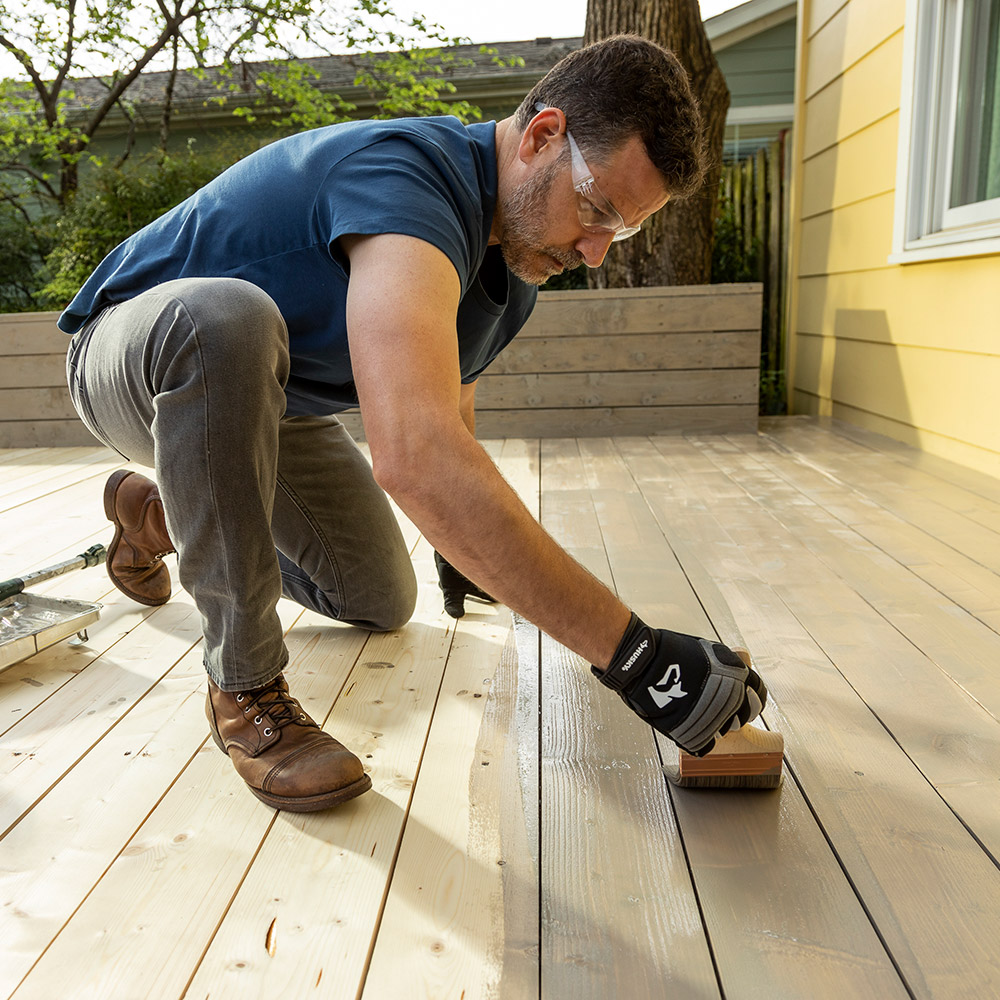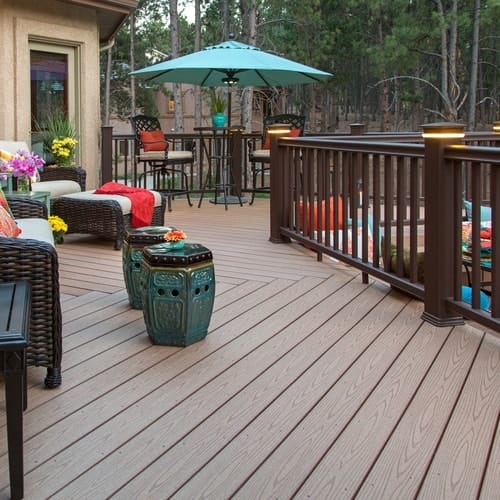Water-Based Stains for a Beautiful Deck: Eco-Friendly and Effective
Water-Based Stains for a Beautiful Deck: Eco-Friendly and Effective
Blog Article
A Comprehensive Overview to Different Kinds of Deck Discoloration Techniques for Ultimate Security and Visual Appeals
In the realm of deck upkeep, the art of tarnishing stands as a pivotal step towards both preserving the honesty of your outside space and boosting its aesthetic appeal. As we browse with the complex world of deck staining strategies, one begins to appreciate the nuanced strategies that can make all the distinction in between a mediocre coating and a perfect one.
Recognizing Various Types of Stains
Various kinds of discolorations are generally made use of in the procedure of deck discoloration to accomplish different visual and protective impacts. Transparent discolorations are optimal for showcasing the natural grain of the wood while supplying very little protection against UV rays and moisture. On the other hand, semi-transparent stains use an equilibrium in between color improvement and protection, allowing some wood grain to show through. For a more nontransparent coating that offers optimum security versus the aspects, strong spots are the preferred option. These discolorations can be found in a vast range of colors and successfully conceal the timber grain.
Furthermore, there are also specialized spots such as printer toners and sealers. Toners include a tip of shade to the timber while providing marginal defense, making them ideal for newer decks with much less wear. Sealers, on the other hand, deal protection against dampness and UV rays without adding shade, making them a popular selection for decks that already boast a preferable shade. Comprehending the qualities and benefits of each kind of tarnish is important for achieving the wanted appearance and toughness for your deck.
Selecting the Right Spot Color
When considering the looks of your deck staining project, the option of stain color plays a crucial function in boosting the safety qualities of the picked tarnish type (Beautiful Deck). The shade you select can substantially influence the overall look of your deck, as well as its ability to withstand the aspects with time
When choosing a discolor shade, it's important to think about the existing color design of your home's outside. Harmonizing the deck tarnish with the overall visual of your property can create a cohesive and visually appealing outdoor room. In addition, the shade of your deck discolor can affect the temperature level of the deck surface area; darker shades tend to take in even more warmth, while lighter shades show sunlight and remain cooler.
In addition, the type of wood you are discoloring will also impact how the tarnish shade shows up. Various timber types can engage with the tarnish in numerous methods, potentially altering the final shade. It's advisable to evaluate the stain on a small, inconspicuous area of the deck to ensure the shade ends up as wanted prior to waging the whole project.
Preparing Your Deck for Staining
To make certain a durable and successful deck staining task, detailed prep work of the deck surface is vital. Begin by cleansing the deck completely to remove dust, grime, mildew, and any old discolor or finish. Use a deck cleaner or a combination of water and cleaning agent together with a tight brush or pressure washing machine to scrub the surface tidy. After cleaning, permit the deck to completely dry completely before proceeding to the following step.
Check the deck for any type of damaged or rotten boards that require to be replaced. Hammer down any type of protruding nails and sand any type of rough locations to guarantee a smooth surface area for staining. Inspect for any type of loose barriers or steps that might need tightening or repair service.
When the deck is clean, completely dry, and in great repair, consider using a wood brightener to restore the deck's natural shade and open the wood pores for better discolor penetration. Safeguard any type of close-by plants, furnishings, or surface areas with plastic sheeting prior to continuing with the discoloration procedure. Correct preparation is crucial to attaining a professional-looking coating and making the most of the longevity of your deck stain.
Using Spot With Numerous Methods
For a flawless and expert finish, the approach of applying discolor plays a vital role in boosting the look and longevity of your deck. There are a number of strategies you can make use of to make certain an effective application of tarnish.
Cleaning is a conventional method that permits accuracy and control over the quantity of tarnish applied. It is excellent for intricate areas and reaching between deck boards (Right Deck Stain). Rolling is a quicker option, covering bigger surface efficiently. However, back-brushing after rolling is advised to level the tarnish and function it right into the wood for much better penetration.
Splashing is another prominent strategy, supplying speed and simplicity of application, particularly for large deck locations. Whichever strategy you pick, guaranteeing correct prep work and adhering to supplier standards will certainly assist achieve a beautiful and resilient stain coating on your deck.

Keeping and Re-staining Your Deck
Correct upkeep and timely re-staining are essential for maintaining the charm and durability of your deck. Routine maintenance tasks include sweeping off debris, cleaning up with a deck cleaner, and examining for any kind of indicators of wear or damages. Dealing with problems without delay can stop more substantial issues in the future. When it pertains to re-staining your deck, the frequency depends on various factors such as the kind of discolor used, the climate in your location, and just how much damage your deck experiences. Usually, it is recommended to re-stain your deck every 2-4 years to keep its security and looks.
Prior to re-staining, ensure the deck is tidy, completely dry, and devoid of any type of previous discolor deposit. Sanding might be necessary to smooth out harsh areas or eliminate old stain that is flaking. Select a premium stain that suits your deck's material and supplies the preferred degree of defense. Apply the discolor evenly using the suitable technique gone over previously in this overview to make sure a beautiful and find lasting finish - Chicago Deck Staining. By remaining positive with maintenance and re-staining, you can appreciate a visually appealing and well-protected deck for many years ahead.
Conclusion
To conclude, understanding the various types of deck discolorations, selecting the right color, effectively preparing the deck, applying stain with different techniques, and maintaining and re-staining the deck are necessary steps for utmost defense and aesthetic appeals. By complying with these steps, you can make sure that her explanation your deck stays in top condition for several years ahead.
Furthermore, the color of your deck stain can affect the temperature level of the deck surface area; darker shades often tend to soak up more warm, while lighter colors mirror sunshine and stay cooler.
It's a good idea to evaluate the tarnish on a small, low-profile location of the deck to make certain the shade turns out as wanted before proceeding with the entire project.

Report this page